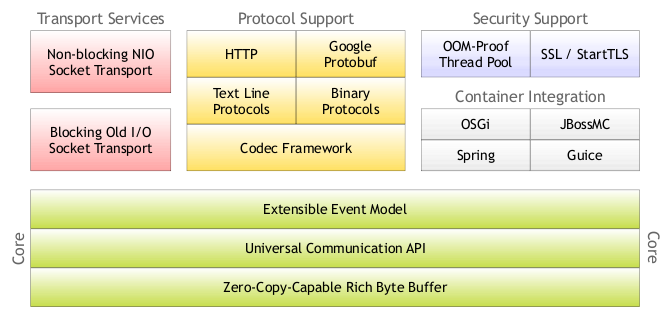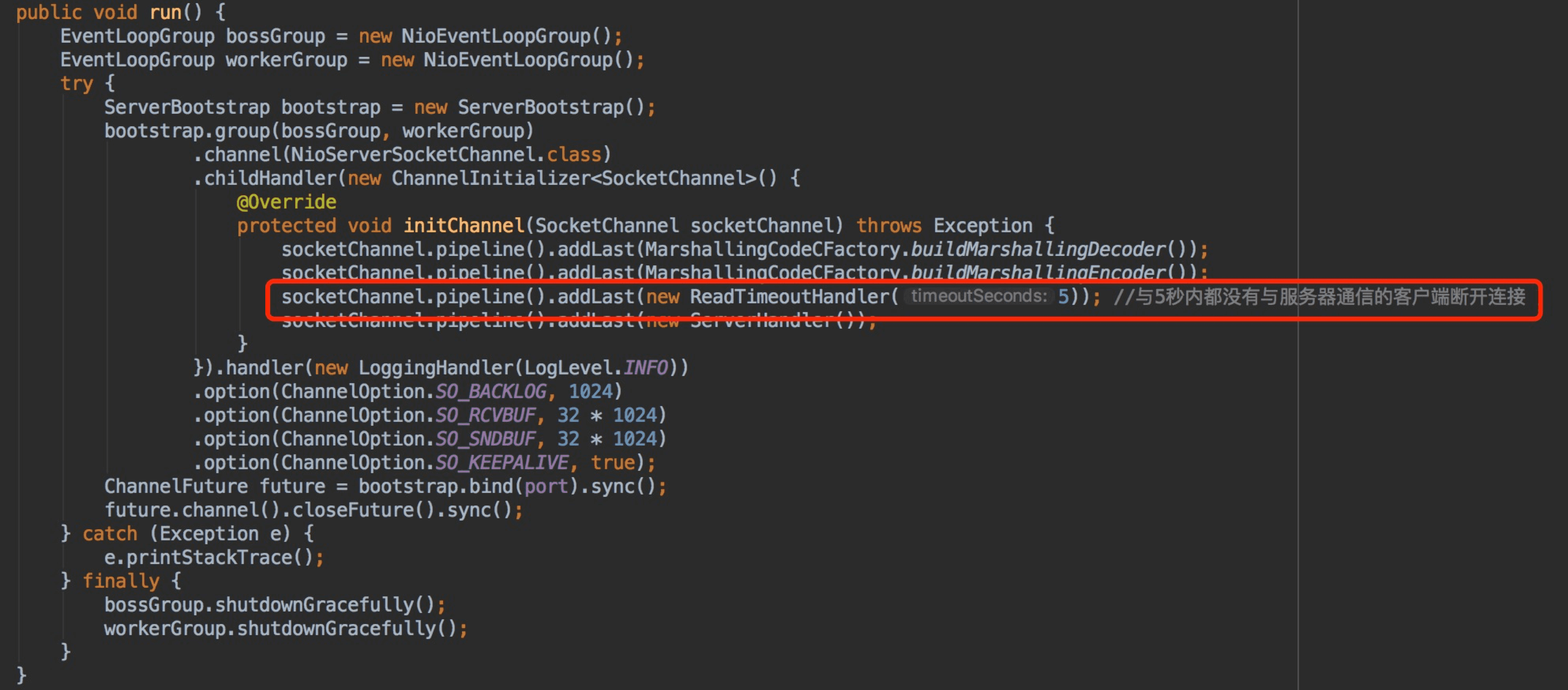| БрМЭЦМі: |
| БОЮФРДздгкcsdnЃЌБОЮФжївЊНщЩмСЫNettyМмЙЙзщГЩЃЌNettyЭЈаХЕФВНжшЃЌNettyжаНтОіTCPеГАќ/В№АќЕФЗНЗЈЕШФкШн
ЃЌЯЃЭћЖдФњФмгаЫљАяжњЁЃ |
|
1.ЮЊЪВУДбЁдёNetty
дкЖдЭЈаХФЃаЭгаСЫЛљБОЕФШЯЪЖЪБЃЌбЇЯАЕНЕФНіНіЪЧвЛИіФЃаЭЃЌШчЙћЯыАбетаЉеце§ЕФгУгкЪЕМЪЙЄзїжаЃЌФЧУДЛЙашвЊВЛЖЯЕФЭъЩЦЁЂРЉеЙКЭгХЛЏЁЃБШШчОЕфЕФTCPЖСАќаДАќЮЪЬтЃЌЛђепЪЧЪ§ОнНгЪеЕФДѓаЁЃЌЪЕМЪЕФЭЈаХДІРэгыгІД№ЕФДІРэТпМЕШЕШвЛаЉЯИНкЮЪЬташвЊШЯецЕФШЅЫМПМЃЌЖјетаЉЖМашвЊДѓСПЕФЪБМфКЭОРњЃЌвдМАЗсИЛЕФОбщЁЃЫљвдЯыбЇКУSocketЭЈаХВЛЪЧМўШнвзЪТЃЌФЧУДНгЯТРДОЭРДбЇЯАвЛЯТаТЕФММЪѕNettyЃЌЮЊЪВУДЛсбЁдёNettyЃПвђЮЊЫќМђЕЅЃЁЪЙгУNettyВЛБиБраДИДдгЕФТпМДњТыШЅЪЕЯжЭЈаХЃЌдйвВВЛашвЊШЅПМТЧадФмЮЪЬтЃЌВЛашвЊПМТЧБрТыЮЪЬтЃЌАыАќЖСаДЕШЮЪЬтЁЃЧПДѓЕФNettyвбОАяЮвУЧЪЕЯжКУСЫЃЌЮвУЧжЛашвЊЪЙгУМДПЩЁЃ
NettyЪЧзюСїааЕФNIOПђМмЃЌЫќЕФНЁзГадЁЂЙІФмЁЂадФмЁЂПЩЖЈжЦадКЭПЩРЉеЙаддкЭЌРрПђМмЖМЪЧЪзЧќвЛжИЕФЁЃЫќвбОЕУЕНГЩАйЩЯЧЇЕФЩЬвЕ/ЩЬгУЯюФПбщжЄЃЌШчHadoopЕФRPCПђМмAvroЁЂRocketMQвдМАжїСїЕФЗжВМЪНЭЈаХПђМмDubboxЕШЕШЁЃ
2.NettyМђНщ
NettyЪЧЛљгкJava NIO client-serverЕФЭјТчгІгУПђМмЃЌЪЙгУNettyПЩвдПьЫйПЊЗЂЭјТчгІгУЃЌР§ШчЗўЮёЦїКЭПЭЛЇЖЫавщЁЃNettyЬсЙЉСЫвЛжжаТЕФЗНЪНРДПЊЗЂЭјТчгІгУГЬађЃЌетжжаТЕФЗНЪНЪЙЫќКмШнвзЪЙгУКЭОпгаКмЧПЕФРЉеЙадЁЃNettyЕФФкВПЪЕЯжЪЧКмИДдгЕФЃЌЕЋЪЧNettyЬсЙЉСЫМђЕЅвзгУЕФAPIДгЭјТчДІРэДњТыжаНтёювЕЮёТпМЁЃNettyЪЧЭъШЋЛљгкNIOЪЕЯжЕФЃЌЫљвдећИіNettyЖМЪЧвьВНЕФЁЃ
ЭјТчгІгУГЬађЭЈГЃашвЊгаНЯИпЕФПЩРЉеЙадЃЌЮоТлЪЧNettyЛЙЪЧЦфЫћЕФЛљгкJava NioЕФПђМмЃЌЖМЛсЬсЙЉПЩРЉеЙадЕФНтОіЗНАИЁЃNettyжавЛИіЙиМќзщГЩВПЗжЪЧЫќЕФвьВНЬиадЃЌБОЦЌЮФеТНЋЬжТлЭЌВНЃЈзшШћЃЉКЭвьВНЃЈЗЧзшШћЃЉЕФIOРДЫЕУїЮЊЪВУДЪЙгУвьВНДњТыНтОіРЉеЙадЮЪЬтвдМАШчКЮЪЙгУвьВНЁЃ
3.NettyМмЙЙзщГЩЃЈНшгУвЛЯТЭјЩЯЕФЭМЦЌЃЉ

4.HelloworldШыУХ
дкбЇЯАNettyжЎЧАЃЌЯШРДЛиЙЫвЛЯТNIOЕФЭЈаХВНжшЃК
ЂйДДНЈServerSocketChannelЃЌЮЊЦфХфжУЗЧзшШћФЃЪНЁЃ
ЂкАѓЖЈМрЬ§ЃЌХфжУTCPВЮЪ§ЃЌТМШыbacklogДѓаЁЕШЁЃ
ЂлДДНЈвЛИіЖРСЂЕФIOЯпГЬЃЌгУгкТжбЏЖрТЗИДгУЦїSelectorЁЃ
ЂмДДНЈSelectorЃЌНЋжЎЧАДДНЈЕФServerSocketChannelзЂВсЕНSelectorЩЯЃЌВЂЩшжУМрЬ§БъЪЖЮЛSelectionKey.OP_ACCEPTЁЃ
ЂнЦєЖЏIOЯпГЬЃЌдкбЛЗЬхжажДааSelector.select()ЗНЗЈЃЌТжбЏОЭаїЕФЭЈЕРЁЃ
ЂоЕБТжбЏЕНДІгкОЭаїзДЬЌЕФЭЈЕРЪБЃЌашвЊНјааВйзїЮЛХаЖЯЃЌШчЙћЪЧACCEPTзДЬЌЃЌЫЕУїЪЧаТЕФПЭЛЇЖЫНгШыЃЌдђЕїгУacceptЗНЗЈНгЪеаТЕФПЭЛЇЖЫЁЃ
ЂпЩшжУаТНгШыПЭЛЇЖЫЕФвЛаЉВЮЪ§ЃЌШчЗЧзшШћЃЌВЂНЋЦфМЬајзЂВсЕНSelectorЩЯЃЌЩшжУМрЬ§БъЪЖЮЛЕШЁЃ
ЂрШчЙћТжбЏЕФЭЈЕРБъЪЖЮЛЪЧREADЃЌдђНјааЖСШЁЃЌЙЙдьBufferЖдЯѓЕШЁЃ
ЂсИќЯИНкЕФЮЪЬтЛЙгаЪ§ОнУЛЗЂЫЭЭъГЩМЬајЗЂЫЭЕФЮЪЬт......
КУРВЃЌПЊЪМбЇЯАNettyСЫЁЃЯШШЅhttp://netty.io/ЩЯЯТдиЫљгаЕФNettyАќЁЃ
NettyЭЈаХЕФВНжшЃК
ЂйДДНЈСНИіNIOЯпГЬзщЃЌвЛИізЈУХгУгкЭјТчЪТМўДІРэЃЈНгЪмПЭЛЇЖЫЕФСЌНгЃЉЃЌСэвЛИідђНјааЭјТчЭЈаХЕФЖСаДЁЃ
ЂкДДНЈвЛИіServerBootstrapЖдЯѓЃЌХфжУNettyЕФвЛЯЕСаВЮЪ§ЃЌР§ШчНгЪмДЋГіЪ§ОнЕФЛКДцДѓаЁЕШЁЃ
ЂлДДНЈвЛИігУгкЪЕМЪДІРэЪ§ОнЕФРрChannelInitializerЃЌНјааГѕЪМЛЏЕФзМБИЙЄзїЃЌБШШчЩшжУНгЪмДЋГіЪ§ОнЕФзжЗћМЏЁЂИёЪНвдМАЪЕМЪДІРэЪ§ОнЕФНгПкЁЃ
ЂмАѓЖЈЖЫПкЃЌжДааЭЌВНзшШћЗНЗЈЕШД§ЗўЮёЦїЖЫЦєЖЏМДПЩЁЃ
КУСЫЃЌЫЕСЫФЧУДЖрЃЌЯТУцОЭРДHelloWorldШыУХАЩЃЁ
ЗўЮёЦїЖЫЃК
public class
Server {
private int port;
public Server(int port) {
this.port = port;
}
public void run() {
EventLoopGroup bossGroup = new NioEventLoopGroup();
//гУгкДІРэЗўЮёЦїЖЫНгЪеПЭЛЇЖЫСЌНг
EventLoopGroup workerGroup = new NioEventLoopGroup();
//НјааЭјТчЭЈаХЃЈЖСаДЃЉ
try {
ServerBootstrap bootstrap = new ServerBootstrap();
//ИЈжњЙЄОпРрЃЌгУгкЗўЮёЦїЭЈЕРЕФвЛЯЕСаХфжУ
bootstrap.group(bossGroup, workerGroup) //АѓЖЈСНИіЯпГЬзщ
.channel(NioServerSocketChannel.class) //жИЖЈNIOЕФФЃЪН
.childHandler(new ChannelInitializer<SocketChannel>()
{ //ХфжУОпЬхЕФЪ§ОнДІРэЗНЪН
@Override
protected void initChannel(SocketChannel socketChannel)
throws Exception {
socketChannel.pipeline().addLast(new ServerHandler());
}
})
/**
* ЖдгкChannelOption.SO_BACKLOGЕФНтЪЭЃК
* ЗўЮёЦїЖЫTCPФкКЫЮЌЛЄгаСНИіЖгСаЃЌЮвУЧГЦжЎЮЊAЁЂBЖгСаЁЃПЭЛЇЖЫЯђЗўЮёЦїЖЫconnectЪБЃЌЛсЗЂЫЭДјгаSYNБъжОЕФАќЃЈЕквЛДЮЮеЪжЃЉЃЌЗўЮёЦїЖЫ
* НгЪеЕНПЭЛЇЖЫЗЂЫЭЕФSYNЪБЃЌЯђПЭЛЇЖЫЗЂЫЭSYN ACKШЗШЯЃЈЕкЖўДЮЮеЪжЃЉЃЌДЫЪБTCPФкКЫФЃПщАбПЭЛЇЖЫСЌНгМгШыЕНAЖгСажаЃЌШЛКѓЗўЮёЦїНгЪеЕН
* ПЭЛЇЖЫЗЂЫЭЕФACKЪБЃЈЕкШ§ДЮЮеЪжЃЉЃЌTCPФкКЫФЃПщАбПЭЛЇЖЫСЌНгДгAЖгСавЦЖЏЕНBЖгСаЃЌСЌНгЭъГЩЃЌгІгУГЬађЕФacceptЛсЗЕЛиЁЃвВОЭЪЧЫЕaccept
* ДгBЖгСажаШЁГіЭъГЩСЫШ§ДЮЮеЪжЕФСЌНгЁЃ
* AЖгСаКЭBЖгСаЕФГЄЖШжЎКЭОЭЪЧbacklogЁЃЕБAЁЂBЖгСаЕФГЄЖШжЎКЭДѓгкChannelOption.SO_BACKLOGЪБЃЌаТЕФСЌНгНЋЛсБЛTCPФкКЫОмОјЁЃ
* ЫљвдЃЌШчЙћbacklogЙ§аЁЃЌПЩФмЛсГіЯжacceptЫйЖШИњВЛЩЯЃЌAЁЂBЖгСаТњСЫЃЌЕМжТаТЕФПЭЛЇЖЫЮоЗЈСЌНгЁЃвЊзЂвтЕФЪЧЃЌbacklogЖдГЬађжЇГжЕФ
* СЌНгЪ§ВЂЮогАЯьЃЌbacklogгАЯьЕФжЛЪЧЛЙУЛгаБЛacceptШЁГіЕФСЌНг
*/
.option(ChannelOption.SO_BACKLOG, 128) //ЩшжУTCPЛКГхЧј
.option(ChannelOption.SO_SNDBUF, 32 * 1024) //ЩшжУЗЂЫЭЪ§ОнЛКГхДѓаЁ
.option(ChannelOption.SO_RCVBUF, 32 * 1024) //ЩшжУНгЪмЪ§ОнЛКГхДѓаЁ
.childOption(ChannelOption.SO_KEEPALIVE, true);
//БЃГжСЌНг
ChannelFuture future = bootstrap.bind(port).sync();
future.channel().closeFuture().sync();
} catch (Exception e) {
e.printStackTrace();
} finally {
workerGroup.shutdownGracefully();
bossGroup.shutdownGracefully();
}
}
public static void main(String[] args) {
new Server(8379).run();
}
} |
ServerHandlerРрЃК
public class
ServerHandler extends ChannelHandlerAdapter {
@Override
public void channelRead(ChannelHandlerContext
ctx, Object msg) throws Exception {
//do something msg
ByteBuf buf = (ByteBuf)msg;
byte[] data = new byte[buf.readableBytes()];
buf.readBytes(data);
String request = new String(data, "utf-8");
System.out.println("Server: " + request);
//аДИјПЭЛЇЖЫ
String response = "ЮвЪЧЗДРЁЕФаХЯЂ";
ctx.writeAndFlush(Unpooled.copiedBuffer ("888".getBytes()));
//.addListener(ChannelFutureListener.CLOSE);
}
@Override
public void exceptionCaught(ChannelHandlerContext
ctx, Throwable cause) throws Exception {
cause.printStackTrace();
ctx.close();
}
} |
ПЭЛЇЖЫЃК
public class
Client {
public static void main(String[] args) throws
InterruptedException {
EventLoopGroup workerGroup = new NioEventLoopGroup();
Bootstrap bootstrap = new Bootstrap();
bootstrap.group(workerGroup)
.channel(NioSocketChannel.class)
.handler(new ChannelInitializer <SocketChannel>()
{
@Override
protected void initChannel(SocketChannel socketChannel)
throws Exception {
socketChannel.pipeline().addLast(new ClientHandler());
}
});
ChannelFuture future = bootstrap. connect("127.0.0.1",
8379).sync();
future.channel().writeAndFlush (Unpooled.copiedBuffer("777".getBytes()));
future.channel().closeFuture().sync();
workerGroup.shutdownGracefully();
}
} |
ClientHandlerРрЃК
public class
ClientHandler extends ChannelHandlerAdapter {
@Override
public void channelRead(ChannelHandlerContext
ctx, Object msg) throws Exception {
try {
ByteBuf buf = (ByteBuf) msg;
byte[] data = new byte[buf.readableBytes()];
buf.readBytes(data);
System.out.println("ClientЃК" + new String(data).trim());
} finally {
ReferenceCountUtil.release(msg);
}
}
@Override
public void exceptionCaught(ChannelHandlerContext
ctx, Throwable cause) throws Exception {
cause.printStackTrace();
ctx.close();
}
} |
дЫааНсЙћЃК


5.TCPеГАќЁЂВ№АќЮЪЬт
ЪьЯЄTCPБрГЬЕФПЩФмЖМжЊЕРЃЌЮоТлЪЧЗўЮёЦїЖЫЛЙЪЧПЭЛЇЖЫЃЌЕБЮвУЧЖСШЁЛђепЗЂЫЭЪ§ОнЕФЪБКђЃЌЖМашвЊПМТЧTCPЕзВуЕФеГАќ/В№АќЛњжЦЁЃ
TCPЪЧвЛИіЁАСїЁБавщЃЌЫљЮНСїОЭЪЧУЛгаНчЯоЕФвХДЋЪ§ОнЁЃДѓМвПЩвдЯыЯѓвЛЯТЃЌШчЙћКгЫЎОЭКУБШЪ§ОнЃЌЫћУЧЪЧСЌГЩвЛЦЌЕФЃЌУЛгаЗжНчЯпЃЌTCPЕзВуВЂВЛСЫНтЩЯВувЕЮёЪ§ОнЕФОпЬхКЌвхЃЌЫќЛсИљОнTCPЛКГхЧјЕФОпЬхЧщПіНјааАќЕФЛЎЗжЃЌвВОЭЪЧЫЕЃЌдквЕЮёЩЯвЛИіЭъећЕФАќПЩФмЛсБЛTCPЗжГЩЖрИіАќНјааЗЂЫЭЃЌвВПЩФмАбЖрИіаЁАќЗтзАГЩвЛИіДѓЕФЪ§ОнАќЗЂЫЭГіШЅЃЌетОЭЪЧЫљЮНЕФеГАќ/В№АќЮЪЬтЁЃ
НтОіЗНАИЃК
ЂйЯћЯЂЖЈГЄЃЌР§ШчУПИіБЈЮФЕФДѓаЁЙЬЖЈЮЊ200ИізжНкЃЌШчЙћВЛЙЛЃЌПеЮЛВЙПеИёЁЃ
ЂкдкАќЮВВПдіМгЬиЪтзжЗћНјааЗжИюЃЌР§ШчМгЛиГЕЕШЁЃ
ЂлНЋЯћЯЂЗжЮЊЯћЯЂЭЗКЭЯћЯЂЬхЃЌдкЯћЯЂЭЗжаАќКЌБэЪОЯћЯЂзмГЄЖШЕФзжЖЮЃЌШЛКѓНјаавЕЮёТпМЕФДІРэЁЃ
NettyжаНтОіTCPеГАќ/В№АќЕФЗНЗЈЃК
ЂйЗжИєЗћРрЃКDelimiterBasedFrameDecoderЃЈздЖЈвхЗжИєЗћЃЉ
ЂкЖЈГЄЃКFixedLengthFrameDecoder


6.NettyБрНтТыММЪѕ
ЭЈГЃЮвУЧвВЯАЙпНЋБрТыЃЈEncodeЃЉГЩЮЊађСаЛЏЃЌЫќНЋЪ§ОнађСаЛЏЮЊзжНкЪ§зщЃЌгУгкЭјТчДЋЪфЁЂЪ§ОнГжОУЛЏЛђепЦфЫћгУЭОЁЃЗДжЎЃЌНтТыЃЈDecodeЃЉ/ЗДађСаЛЏЃЈdeserializationЃЉ
АбДгЭјТчЁЂДХХЬЕШЖСШЁЕФзжНкЪ§зщЛЙдГЩдЪМЖдЯѓЃЈЭЈГЃЪЧдЪМЖдЯѓЕФПНБДЃЉЃЌвдЗНБуКѓајЕФвЕЮёТпМВйзїЁЃНјаадЖГЬПчНјГЬЗўЮёЕїгУЪБЃЈР§ШчRPCЕїгУЃЉЃЌашвЊЪЙгУЬиЖЈЕФБрНтТыММЪѕЃЌЖдашвЊНјааЭјТчДЋЪфЕФЖдЯѓзіБрТыЛђепНтТыЃЌвдБуЭъГЩдЖГЬЕїгУЁЃ
жїСїЕФБрНтТыПђМмЃК
ЂйJBossЕФMarshallingАќ
ЂкgoogleЕФProtobuf
ЂлЛљгкProtobufЕФKyro
ЂмMessagePackПђМм
ЩЯДњТыЃЌвЛЖСОЭЖЎЃЌзЂвтКьЩЋзжЬхВПЗжЁЃ
ЗўЮёЦїЖЫЃК
public class
Server {
public Server(int port) {
EventLoopGroup bossGroup = newNioEventLoopGroup();
EventLoopGroup workerGroup = newNioEventLoopGroup();
try {
ServerBootstrap bootstrap = newServerBootstrap();
bootstrap.group(bossGroup, workerGroup)
.channel(NioServerSocketChannel.class)
.handler(newLoggingHandler(LogLevel.INFO))
.childHandler(newChannelInitializer<SocketChannel>()
{
@Override
protected voidinitChannel(SocketChannel
socketChannel) throws Exception {
socketChannel.pipeline().addLast (MarshallingCodeCFactory.buildMarshallingDecoder());
socketChannel.pipeline().addLast (MarshallingCodeCFactory.buildMarshallingEncoder());
socketChannel.pipeline().addLast (new ServerHandler());
}
})
.option(ChannelOption.SO_BACKLOG,1024)
.option(ChannelOption.SO_RCVBUF,
32 * 1024)
.option(ChannelOption.SO_SNDBUF,
32 * 1024)
.option(ChannelOption.SO_KEEPALIVE,
true);
ChannelFuture future = bootstrap.bind(port).sync();
future.channel().closeFuture().sync();
} catch (Exception e) {
e.printStackTrace();
} finally {
bossGroup.shutdownGracefully();
workerGroup.shutdownGracefully();
}
}
public static void main(String[] args) {
new Server(8765);
}
} |
ServerHandlerРрЃК
public classServerHandler
extends ChannelHandlerAdapter {
@Override
public voidexceptionCaught(ChannelHandlerContext
ctx, Throwable cause) throws Exception {
cause.printStackTrace();
ctx.close();
}
@Override
public voidchannelActive(ChannelHandlerContext
ctx) throws Exception {
super.channelActive(ctx);
}
@Override
public void channelRead(ChannelHandlerContextctx,
Object msg) throws Exception {
Request request = (Request) msg;
System.out.println("Server:"+
request.getId() + "," + request.getName()
+ "," +request.getReqeustMessag());
Response response = new Response();
response.setId(request.getId());
response.setName("response "+
request.getId());
response.setResponseMessage("ЯьгІФкШнЃК"
+request.getReqeustMessag());
byte[] unGizpData =GzipUtils.unGzip(request.getAttachment());
char separator = File.separatorChar;
FileOutputStream outputStream = newFileOutputStream(System.getProperty("user.dir")
+ separator +"recieve" + separator +
"1.png");
outputStream.write(unGizpData);
outputStream.flush();
outputStream.close();
ctx.writeAndFlush(response);
}
} |
ПЭЛЇЖЫЃК
public class
Client {
public static void main(String[] args) {
EventLoopGroup workerGroup = newNioEventLoopGroup();
try {
Bootstrap bootstrap = new Bootstrap();
bootstrap.group(workerGroup)
.handler(newLoggingHandler(LogLevel.INFO))
.channel(NioSocketChannel.class)
.handler(newChannelInitializer<SocketChannel>()
{
@Override
protected voidinitChannel(SocketChannel socketChannel)
throws Exception {
socketChannel.pipeline().addLast (MarshallingCodeCFactory.buildMarshallingEncoder());
socketChannel.pipeline().addLast (MarshallingCodeCFactory.buildMarshallingDecoder());
socketChannel.pipeline().addLast (new ClientHandler());
}
});
ChannelFuture future =bootstrap.connect (new InetSocketAddress("127.0.01",
8765)).sync();
for(int i=1; i<=5; i++) {
Request request = newRequest();
request.setId(i);
request.setName("pro"+
i);
request.setReqeustMessag("Ъ§ОнаХЯЂ"
+ i);
//ДЋЪфЭМЦЌ
char separator =File.separatorChar;
File file = newFile(System.getProperty("user.dir")
+ separator + "source"+ separator +
"2.jpg");
FileInputStream inputStream =
newFileInputStream(file);
byte[] data = newbyte[inputStream.available()];
inputStream.read(data);
inputStream.close();
byte[] gzipData =GzipUtils.gzip(data);
request.setAttachment(gzipData);
future.channel().writeAndFlush(request);
}
future.channel().closeFuture().sync();
} catch (Exception e) {
e.printStackTrace();
} finally {
workerGroup.shutdownGracefully();
}
}
} |
ClientHandlerРрЃК
public classClientHandler
extends ChannelHandlerAdapter {
@Override
public voidexceptionCaught(ChannelHandlerContext
ctx, Throwable cause) throws Exception {
super.exceptionCaught(ctx, cause);
}
@Override
public voidchannelActive(ChannelHandlerContext
ctx) throws Exception {
super.channelActive(ctx);
}
@Override
public voidchannelRead(ChannelHandlerContext
ctx, Object msg) throws Exception {
Response response = (Response) msg;
System.out.println("Client:"+
response.getId() + "," + response.getName()
+ "," +response.getResponseMessage());
}
} |
MarshallingЙЄОпРрЃК
public final
classMarshallingCodeCFactory {
/**
* ДДНЈJboss MarshallingНтТыЦїMarshallingDecoder
* @return MarshallingDecoder
*/
public static MarshallingDecoderbuildMarshallingDecoder()
{
//ЪзЯШЭЈЙ§MarshallingЙЄОпРрЕФОЋЭЈЗНЗЈЛёШЁMarshallingЪЕР§ЖдЯѓ
ВЮЪ§serialБъЪЖДДНЈЕФЪЧjavaађСаЛЏЙЄГЇЖдЯѓЁЃ
final MarshallerFactorymarshallerFactory
=Marshalling.getProvidedMarshallerFactory("serial");
//ДДНЈСЫMarshallingConfigurationЖдЯѓЃЌХфжУСЫАцБОКХЮЊ5
final MarshallingConfigurationconfiguration
= new MarshallingConfiguration();
configuration.setVersion(5);
//ИљОнmarshallerFactoryКЭconfigurationДДНЈprovider
UnmarshallerProvider provider=
new DefaultUnmarshallerProvider(marshallerFactory,
configuration);
//ЙЙНЈNettyЕФMarshallingDecoderЖдЯѓЃЌСЉИіВЮЪ§ЗжБ№ЮЊproviderКЭЕЅИіЯћЯЂађСаЛЏКѓЕФзюДѓГЄЖШ
MarshallingDecoder decoder =new
MarshallingDecoder(provider, 1024 * 1024);
return decoder;
}
/**
* ДДНЈJboss MarshallingБрТыЦїMarshallingEncoder
* @return MarshallingEncoder
*/
public static MarshallingEncoderbuildMarshallingEncoder()
{
final MarshallerFactorymarshallerFactory
=Marshalling.getProvidedMarshallerFactory("serial");
final MarshallingConfigurationconfiguration
= new MarshallingConfiguration();
configuration.setVersion(5);
MarshallerProvider provider
=new DefaultMarshallerProvider(marshallerFactory,
configuration);
//ЙЙНЈNettyЕФMarshallingEncoderЖдЯѓЃЌMarshallingEncoderгУгкЪЕЯжађСаЛЏНгПкЕФPOJOЖдЯѓађСаЛЏЮЊЖўНјжЦЪ§зщ
MarshallingEncoder encoder =new
MarshallingEncoder(provider);
return encoder;
}
} |
GizpбЙЫѕгыНтбЙЫѕЙЄОпРрЃК
public classGzipUtils
{
public static byte[] gzip(byte[] val)throws
IOException {
ByteArrayOutputStream bos = newByteArrayOutputStream(val.length);
GZIPOutputStream gos = null;
try {
gos = new GZIPOutputStream(bos);
gos.write(val, 0, val.length);
gos.finish();
gos.flush();
bos.flush();
val = bos.toByteArray();
} finally {
if (gos != null)
gos.close();
if (bos != null)
bos.close();
}
return val;
}
public static byte[] unGzip(byte[] buf)throws
IOException {
GZIPInputStream gzi = null;
ByteArrayOutputStream bos = null;
try {
gzi = new GZIPInputStream(newByteArrayInputStream(buf));
bos = newByteArrayOutputStream(buf.length);
int count = 0;
byte[] tmp = new byte[2048];
while ((count = gzi.read(tmp)) !=-1)
{
bos.write(tmp, 0, count);
}
buf = bos.toByteArray();
} finally {
if (bos != null) {
bos.flush();
bos.close();
}
if (gzi != null)
gzi.close();
}
return buf;
}
} |
7.зюМбЪЕМљ
ЃЈ1ЃЉЪ§ОнЭЈаХ
ЮвУЧашвЊСЫНтдкеце§ЯюФПжаШчКЮЪЙгУNettyЃЌДѓЬхЩЯЖдгквЛаЉВЮЪ§ЩшжУЖМЪЧИљОнЗўЮёЦїадФмОіЖЈЕФЁЃЮвУЧашвЊПМТЧЕФЮЪЬтЪЧСНЬЈЛњЦїЃЈЩѕжСЖрЬЈЃЉЪЙгУNettyдѕбљНјааЭЈаХЁЃ
ДѓЬхЩЯЗжЮЊШ§жжЃК
ЂйЪЙгУГЄСЌНгЭЈЕРВЛЖЯПЊЕФаЮЪННјааЭЈаХЃЌвВОЭЪЧЗўЮёЦїКЭПЭЛЇЖЫЕФЭЈЕРвЛжБДІгкПЊЦєзДЬЌЃЌШчЙћЗўЮёЦїадФмзуЙЛКУЃЌВЂЧвПЭЛЇЖЫЪ§СПвВБШНЯЩЯЕФЧщПіЯТЃЌЭЦМіетжжЗНЪНЁЃ
ЂквЛДЮадХњСПЬсНЛЪ§ОнЃЌВЩгУЖЬСЌНгЗНЪНЁЃвВОЭЪЧЫЕЯШАбЪ§ОнБЃДцЕНБОЕиСйЪБЛКДцЧјЛђепСйЪББэЃЌЕБДяЕННчжЕЪБНјаавЛДЮадХњСПЬсНЛЃЌгжЛђепИљОнЖЈЪБШЮЮёТжбЏЬсНЛЃЌ
етжжЧщПіЕФБзЖЫЪЧзіВЛЕНЪЕЪБадДЋЪфЃЌЖдЪЕЪБадвЊЧѓВЛИпЕФгІгУГЬађжаЭЦМіЪЙгУЁЃ
ЂлЪЙгУвЛжжЬиЪтЕФГЄСЌНгЃЌдкФГвЛжИЖЈЪБМфЖЮФкЃЌЗўЮёЦїгыФГЬЈПЭЛЇЖЫУЛгаШЮКЮЭЈаХЃЌдђЖЯПЊСЌНгЁЃЯТДЮСЌНгдђЪЧПЭЛЇЖЫЯђЗўЮёЦїЗЂЫЭЧыЧѓЕФЪБКђЃЌдйДЮНЈСЂСЌНгЁЃ
дкетРяНЋНщЩмЪЙгУNettyЪЕЯжЕкШ§жжЗНЪНЕФСЌНгЃЌЕЋЪЧЮвУЧашвЊПМТЧСНИівђЫиЃК
ЂйШчКЮдкГЌЪБЃЈМДЗўЮёЦїКЭПЭЛЇЖЫУЛгаШЮКЮЭЈаХЃЉКѓЙиБеЭЈЕРЃПЙиБеЭЈЕРКѓгжШчКЮдйДЮНЈСЂСЌНгЃП
ЂкПЭЛЇЖЫхДЛњЪБЃЌЮвУЧЮоашПМТЧЃЌЯТДЮжиЦєПЭЛЇЖЫжЎКѓОЭПЩвдгыЗўЮёЦїНЈСЂСЌНгЃЌЕЋЗўЮёЦїхДЛњЪБЃЌПЭЛЇЖЫШчКЮгыЗўЮёЦїЖЫЭЈаХЃП
ЗўЮёЦїЖЫЃКдіМгСЫКьЩЋПђВПЗж

ПЭЛЇЖЫЃЈзЂвтКьЩЋзжЬхВПЗжЃЉЃК
public class
Client {
private static class SingleHodler {
static final Client client = newClient();
}
public static Client getInstance() {
return SingleHodler.client;
}
private EventLoopGroup workerGroup;
private Bootstrap bootstrap;
private ChannelFuture future;
private Client() {
workerGroup = new NioEventLoopGroup();
bootstrap = new Bootstrap();
bootstrap.group(workerGroup)
.channel(NioSocketChannel.class)
.handler(newChannelInitializer<SocketChannel>()
{
@Override
protected voidinitChannel(SocketChannel
socketChannel) throws Exception {
socketChannel.pipeline().addLast (MarshallingCodeCFactory.buildMarshallingEncoder());
socketChannel.pipeline().addLast (MarshallingCodeCFactory.buildMarshallingDecoder());
socketChannel.pipeline().addLast (newReadTimeoutHandler(5));
//5УыКѓЮДгыЗўЮёЦїЭЈаХЃЌдђЖЯПЊСЌНгЁЃ
socketChannel.pipeline().addLast (new ClientHandler());
}
});
}
public void connect() {
try {
future =bootstrap.connect("127.0.0.1",
8765).sync();
} catch (InterruptedException e) {
e.printStackTrace();
}
}
public ChannelFuture getFuture() {
if(future == null ||!future.channel().isActive())
{
this.connect();
}
return future;
}
public static void main(String[] args)throws
InterruptedException {
Client client = getInstance();
ChannelFuture future = client.getFuture();
for(int i=1; i<=3; i++) {
Message message = new Message(i,"pro"
+ i, "Ъ§ОнаХЯЂ" + i);
future.channel().writeAndFlush(message);
Thread.sleep(4000); //анУп4УыКѓдйЗЂЫЭЪ§Он
}
future.channel().closeFuture().sync();
new Thread(() -> {
try {
System.out.println("згЯпГЬПЊЪМ....");
ChannelFuture f =client.getFuture();
Message message = newMessage(4,
"pro" + 4, "Ъ§ОнаХЯЂ" + 4);
f.channel().writeAndFlush(message);
f.channel().closeFuture().sync();
} catch (Exception e) {
e.printStackTrace();
}
}).start();
System.out.println("жїЯпГЬЭЫГі......");
}
} |
ЦфЫћЕФРргыжЎЧАЕФвЛбљЃЌУЛгаБфЛЏЁЃ
дЫааНсЙћЃК


ЃЈ2ЃЉаФЬјМьВт
ЮвУЧЪЙгУSocketЭЈаХвЛАуОГЃЛсДІРэЖрИіЗўЮёЦїжЎМфЕФаФЬјМьВтЃЌвЛАуРДНВЮвУЧШЅЮЌЛЄЗўЮёЦїМЏШКЃЌПЯЖЈвЊгавЛЬЈЛђЖрЬЈЗўЮёЦїжїЛњЃЈMasterЃЉЃЌШЛКѓЛЙгІИУгаNЬЈЃЈSlaveЃЉЃЌФЧУДЮвУЧЕФжїЛњПЯЖЈвЊЪБЪБПЬПЬжЊЕРздМКЯТУцЕФДгЗўЮёЦїЕФИїЗНУцЧщПіЃЌШЛКѓНјааЪЕЪБМрПиЕФЙІФмЁЃетИідкЗжВМЪНМмЙЙРяНЛзіаФЬјМьВтЛђепаФЬјМрПиЁЃзюМбДІРэЗНАИЪЧЪЙгУвЛаЉЭЈаХПђМмНјааЪЕЯжЃЌNettyОЭПЩвдзіетбљЕФЪТЁЃ
Server
public class
Server {
public Server(int port) {
EventLoopGroup bossGroup = newNioEventLoopGroup();
EventLoopGroup workerGroup = newNioEventLoopGroup();
try {
ServerBootstrap bootstrap = newServerBootstrap();
bootstrap.group(bossGroup,workerGroup)
.channel(NioServerSocketChannel.class)
.childHandler(newChannelInitializer<SocketChannel>()
{
@Override
protected voidinitChannel(SocketChannel
sc) throws Exception {
sc.pipeline().addLast (MarshallingCodeCFactory.buildMarshallingEncoder());
sc.pipeline().addLast (MarshallingCodeCFactory.buildMarshallingDecoder());
sc.pipeline().addLast (new ServerHeartBeatHandler());
}
})
.handler(newLoggingHandler(LogLevel.INFO))
.option(ChannelOption.SO_BACKLOG,
1024);
ChannelFuture future =bootstrap.bind(new
InetSocketAddress("127.0.0.1", port)).sync();
future.channel().closeFuture().sync();
} catch (Exception e) {
e.printStackTrace();
} finally {
bossGroup.shutdownGracefully();
workerGroup.shutdownGracefully();
}
}
public static void main(String[] args) {
new Server(8765);
}
} |
ServerHeartBeatHandlerРрЃК
public classServerHeartBeatHandler
extends ChannelHandlerAdapter {
private static Map<String, String>AUTH_IP_MAP
= new HashMap<>();
private static final String SUCCESS_KEY ="auth_success_key";
static {
AUTH_IP_MAP.put("192.168.3.176","1234");
}
private boolean auth(ChannelHandlerContextctx,
Object msg) {
String[] rets = ((String)msg).split(",");
String auth = AUTH_IP_MAP.get(rets[0]);
if(auth != null &&auth.equals(rets[1]))
{
ctx.writeAndFlush(SUCCESS_KEY);
return true;
} else {
ctx.writeAndFlush("authfailure!") .addListener(ChannelFutureListener.CLOSE);
return false;
}
}
@Override
public void channelRead(ChannelHandlerContextctx,
Object msg) throws Exception {
if(msg instanceof String) {
auth(ctx, msg);
} else if(msg instanceof RequestInfo)
{
RequestInfo info = (RequestInfo)msg;
System.out.println("----------------------------------------------");
System.out.println("ЕБЧАжїЛњipЃК"
+info.getIp());
System.out.println("ЕБЧАжїЛњcpuЃКЧщПі");
Map<String, Object> cpuMap =info.getCpuPercMap();
System.out.println("змЪЙгУТЪЃК"
+ cpuMap.get("combined"));
System.out.println("гУЛЇЪЙгУТЪЃК"
+cpuMap.get("user"));
System.out.println("ЯЕЭГЪЙгУТЪЃК"
+cpuMap.get("sys"));
System.out.println("ЕШД§ТЪЃК"
+cpuMap.get("wait"));
System.out.println("ПеЯаТЪЃК"
+cpuMap.get("idle"));
System.out.println("ЕБЧАжїЛњmemoryЧщПіЃК");
Map<String, Object> memMap =info.getMemoryMap();
System.out.println("ФкДцзмСПЃК"
+memMap.get("total"));
System.out.println("ЕБЧАФкДцЪЙгУСПЃК"
+memMap.get("used"));
System.out.println("ЕБЧАФкДцЪЃгрСПЃК"
+memMap.get("free"));
System.out.println("-----------------------------------------------");
ctx.writeAndFlush("inforeceived!");
} else {
ctx.writeAndFlush("connectfailure")
.addListener(ChannelFutureListener.CLOSE);
}
}
} |
ClientРрЃК
public class
Client {
public static void main(String[] args) {
EventLoopGroup workerGroup = newNioEventLoopGroup();
try {
Bootstrap bootstrap = newBootstrap();
bootstrap.group(workerGroup)
.channel(NioSocketChannel.class)
.handler(newChannelInitializer<SocketChannel>()
{
@Override
protected void initChannel(SocketChannelsc)
throws Exception {
sc.pipeline().addLast (MarshallingCodeCFactory.buildMarshallingDecoder());
sc.pipeline().addLast (MarshallingCodeCFactory.buildMarshallingEncoder());
sc.pipeline().addLast (new ClientHeartBeatHandler());
}
});
ChannelFuture future =bootstrap.connect (new InetSocketAddress("127.0.0.1",
8765)).sync();
future.channel().closeFuture().sync();
} catch (Exception e) {
e.printStackTrace();
} finally {
workerGroup.shutdownGracefully();
}
}
} |
ClientHeartBeatHandlerРрЃК
public classClientHeartBeatHandler
extends ChannelHandlerAdapter {
private ScheduledExecutorService scheduled=
Executors.newScheduledThreadPool(1);
private ScheduledFuture<> heartBeat;
private InetAddress address;
private static final String SUCCESS_KEY ="auth_success_key";
@Override
public voidchannelActive(ChannelHandlerContext
ctx) throws Exception {
address = InetAddress.getLocalHost();
String ip = address.getHostAddress();
String key = "1234";
String auth = ip + "," + key;
ctx.writeAndFlush(auth);
}
@Override
public voidexceptionCaught(ChannelHandlerContext
ctx, Throwable cause) throws Exception {
cause.printStackTrace();
if(heartBeat != null) {
heartBeat.cancel(true);
heartBeat = null;
}
ctx.fireExceptionCaught(cause);
}
@Override
public voidchannelRead(ChannelHandlerContext
ctx, Object msg) throws Exception {
try {
if(msg instanceof String) {
String data = (String) msg;
if(SUCCESS_KEY.equals(data)) {
heartBeat =scheduled.scheduleWithFixedDelay(new
HeartBeatTask(ctx), 0, 5,TimeUnit.SECONDS);
System.out.println(msg);
} else {
System.out.println(msg);
}
}
} finally {
ReferenceCountUtil.release(msg);
}
}
private class HeartBeatTask implements Runnable{
private final ChannelHandlerContextctx;
publicHeartBeatTask(ChannelHandlerContext
ctx) {
this.ctx = ctx;
}
@Override
public void run() {
try {
RequestInfo requestInfo = newRequestInfo();
requestInfo.setIp(address.getHostAddress());
Sigar sigar = new Sigar();
CpuPerc cpuPerc =sigar.getCpuPerc();
Map<String, Object>cpuPercMap
= new HashMap<>();
cpuPercMap.put("combined",cpuPerc.getCombined());
cpuPercMap.put("user",
cpuPerc.getUser());
cpuPercMap.put("sys",cpuPerc.getSys());
cpuPercMap.put("wait",
cpuPerc.getWait());
cpuPercMap.put("idle",cpuPerc.getIdle());
Mem mem = sigar.getMem();
Map<String, Object>memoryMap
= new HashMap<>();
memoryMap.put("total",
mem.getTotal() / (1024 * 1024));
memoryMap.put("used",mem.getUsed()
/ (1024 * 1024));
memoryMap.put("free",mem.getFree()
/ (1024 * 1024));
requestInfo.setCpuPercMap(cpuPercMap);
requestInfo.setMemoryMap(memoryMap);
ctx.writeAndFlush(requestInfo);
} catch (Exception e) {
e.printStackTrace();
}
}
}
} |
RequestInfoРрЃК
public classRequestInfo
implements Serializable {
private String ip ;
private Map<String, Object>cpuPercMap
;
private Map<String, Object>memoryMap;
//.. other field
public String getIp() {
return ip;
}
public void setIp(String ip) {
this.ip = ip;
}
public Map<String, Object>getCpuPercMap()
{
return cpuPercMap;
}
public voidsetCpuPercMap(Map<String,
Object> cpuPercMap) {
this.cpuPercMap = cpuPercMap;
}
public Map<String, Object>getMemoryMap()
{
return memoryMap;
}
public void setMemoryMap(Map<String,Object>
memoryMap) {
this.memoryMap = memoryMap;
}
} |
MarshallingCodeCFactoryРрОЭВЛЬљГіРДСЫЃЌИњжЎЧАЕФвЛбљЁЃ
дЫааНсЙћЃК


УП5УыЗЂЫЭвЛДЮЪ§ОнЕНЗўЮёЦїЖЫЃЌетбљжїЗўЮёЦїОЭПЩвджЊЕРУПЬЈДгЗўЮёЦїЕФзДЬЌСЫЁЃЕБШЛЃЌетжЛЪЧвЛИіМђЕЅЕФаЁР§згЃЌецЪЕЛЗОГжаПЯЖЈашвЊИќбЯИёЕФаЃбщЁЃ
|